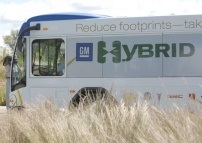






--"The Bus Stops Here" is produced monthly by members of the Madison Area Bus Advocates
 A hybrid busIt’s time to leverage Dane County’s strong tradition of civic-mindedness and community support to help achieve public transit and environmental goals. At a time of record transit ridership nationwide that offers mobility, economic, health and environmental benefits, public funding is often tight and insufficient. In some Wisconsin communities that have seen service cuts and/or fare increases rider numbers are down, but in areas where service hasn’t been cut like La Crosse and Valley Transit (Appleton and the Fox Valley) ridership has increased.
A hybrid busIt’s time to leverage Dane County’s strong tradition of civic-mindedness and community support to help achieve public transit and environmental goals. At a time of record transit ridership nationwide that offers mobility, economic, health and environmental benefits, public funding is often tight and insufficient. In some Wisconsin communities that have seen service cuts and/or fare increases rider numbers are down, but in areas where service hasn’t been cut like La Crosse and Valley Transit (Appleton and the Fox Valley) ridership has increased.
Madison Metro’s experience helps illustrate the connection of service and ridership. When Madison Metro cut service 10 percent in 2012, by cutting UW Madison circular routes due to funding, ridership dipped despite an overall upward trend. In 2013, Metro added new routes to the Owl Creek and Grandview Commons neighborhoods – and recorded its second-highest ridership ever (the highest ridership was 2011, before the cuts). Madison Metro also joins other transit systems in ongoing overcrowding problems – a major source of complaints and a factor that limits bus rider numbers.
While Madison Metro needs more buses, and must address bus storage and maintenance capacity, you would think maintaining the current level of service is a given. You would also think with budget and environmental concerns there would be at least a one-for-one replacement in the number of hybrid buses (about 10 percent of Metro’s bus fleet) that save gas and fuel dollars. Yet that “given” is not obvious. Previous federal funding allowed Metro to replace about 15 buses a year, but expected cuts have reduced that number to four, meaning older buses may need to be patched up to ride longer and at greater maintenance costs. We need strong advocacy for busing – and Dane County residents communicating to local, state and national leaders about the importance of busing can make a difference.
Beyond traditional advocacy, the gap between funding and service levels has spurred innovative thinking elsewhere. In Detroit, a 25 year-old with no transportation experience saw a gap in public transit, bought six old buses outfitting them to run on 100 percept local bio-fuel, and started the Detroit Bus Company (DBC). A sign on one of DBC’s buses speaks to its non-traditional approach: “TAKE WHAT YOU KNOW ABOUT PUBLIC TRANSIT AND THROW IT UNDER THE BUS.” DBC is still experimenting with its business model, but is already providing service connecting students to afterschool enrichment programs where other public transit options don’t exist.
In another approach, a Stanford University professor has advocated nonprofit organizations start running public transit because, in part, of their ability to solicit donations. Innovative thinking, however, need not upend existing public transit operations for success – instead it can augment them.
What kind of innovations might we do “here at home” working with Madison Metro – and how can the Dane County community help? What about a Madison Metro Transit Green Bus Card program that buys hybrid buses? Using a model similar to MG&E’s Green Power Tomorrow program, the Green Bus Card program could ask individual riders and Metro Pass Program partners to voluntarily pay additional money to purchase passes that help purchase hybrid buses. MG&E's program has 10,000 customers, suggesting substantial public interest in local “green power” alternatives. Beyond the bus riding public, civic-minded business and community members could also purchase Green Bus Cards as a way of supporting the local economy, the environment and the greater community with better transit options. The Green Bus Card program could also help Metro save operating costs through more energy-efficient hybrid buses.
What might the program look like? It could be as simple as an additional $10 purchase with a monthly or youth semester/summer bus pass. For example, if about 1,750 Green Bus Card monthly passes were purchased over the course of a year, that additional $10 per pass would pay the difference between a standard diesel and a fuel-efficient hybrid bus. About 5,000 Green Bus Card monthly passes on an annual basis would pay for a fuel-efficient hybrid bus outright.
In order to increase the Green Bus Card’s popularity, local business leadership could promote the program with signage (and direct support) – particularly if they are on/near bus routes. Local foundations might offer direct support. Local nonprofit leaders and other opinion leaders could also promote the program through their organizations.
Over the course of time the additional funding stream of a Green Bus Card program could add up. Transit buses serve about 12 years before increased maintenance costs make replacement more economical. Green Bus Card program bus purchases could mean more hybrid buses saving fuel, operating costs and the environment for a long time. Beyond these benefits, a Green Bus Card program would provide additional public awareness of and participation in Metro’s busing and environmental sustainability efforts. When Dane County residents have more transportation options that save money and the environment – it’s a “win-win” for all of us. A Metro Transit Green Bus Card program is a step in the right direction.
|
|
|
Welcome to the Madison Commons, a website designed to provide news and information about all of Madison's neighborhoods and a crossroads for the discussion of community issues. The name comes from the idea of a village commons, a place for news, talk, debate, and some entertainment, too, that's open to everyone.
All rights reserved. Read more about the Madison Commons and its partners.

